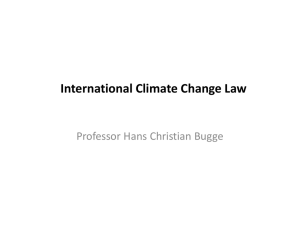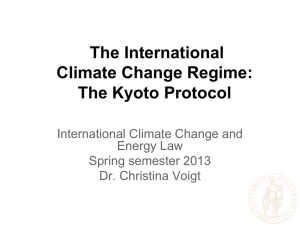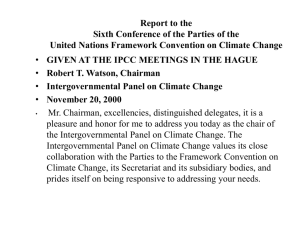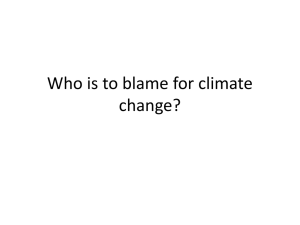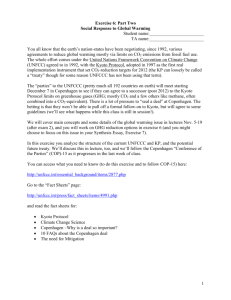Honors Seminar - Advanced Presentation
advertisement
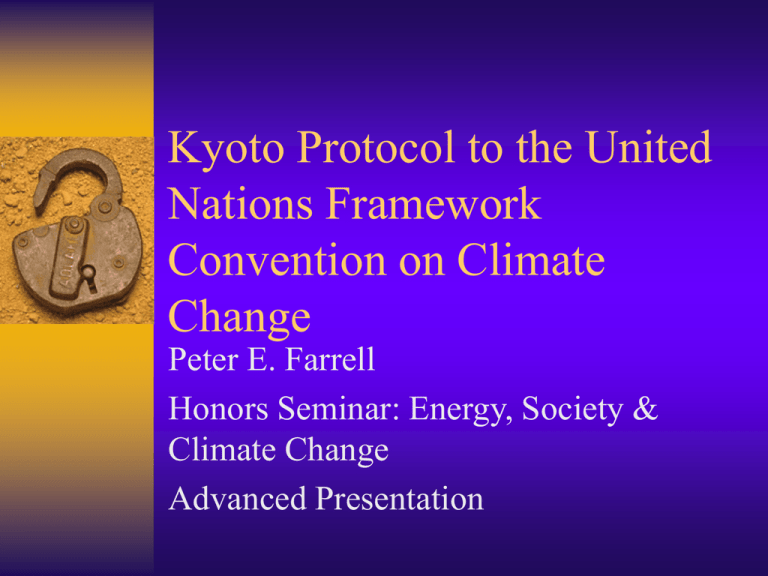
Kyoto Protocol to the United Nations Framework Convention on Climate Change Peter E. Farrell Honors Seminar: Energy, Society & Climate Change Advanced Presentation A Brief History of the Events Leading to the Kyoto Protocol COP 1, in March of 1995, saw the passage of the Berlin Mandate, which called for new negotiations on more detailed commitments for industrialized countries under the UNFCCC. On December 11, 1997 the Kyoto Protocol was officially adopted at COP 3 in Kyoto Japan. In 1998 a new round of negotiations on Kyoto were launched at COP 4 in Buenos Aires. History (cont.) Negotiations on the rules of implementing the Kyoto Protocol resumed during COP 6 in Bonn, Germany, July 2001. Building on the Bonn Agreements negotiators at COP 7 (Marrakech, Morocco, October 2001) adopted a comprehensive package of decisions known as the Marrakech Accords. What is the Kyoto Protocol? In general, a protocol is an international agreement that stands on its own but is linked to an existing treaty. More specifically, the Kyoto Protocol can be seen as an agreement, which supplements and strengthens the Framework Convention. Indeed, the Kyoto Protocol reaffirms the concerns and principles set out in the Convention and then builds on these by adding tougher, more specific commitments. What is the Kyoto Protocol: 4 Main Elements The Kyoto Protocol and its rulebook, set out in the Marrakech Accords, consist of five main elements: 1. Commitments A. Specific emissions commitments B. General commitments 2. Implementation A. Domestic policies and measures B. Land use, land-use change and forestry sector C. Joint implementation D. Clean development mechanism E. Emissions trading What is the Kyoto Protocol: 4 Main Elements 3. Compliance A. Facilitative Branch B. Enforcement Branch 4. Minimizing impacts on developing countries A. Adaptation Fund Commitments: General All Parties to the Protocol are subject to a set of general commitments that mirror those of the Framework Convention. These include: Taking steps to improve the quality of emissions data. Promoting environmentally-friendly technology transfer. Supporting climate change education, training and public awareness. Cooperating on international climate observation. 1. Commitments: Specific At the real heart of the Kyoto Protocol lies its set of legally-binding emissions targets for industrialized countries. These emissions targets amount to a total cut, among all Annex I Parties, of at least 5% from 1990 levels by 2008-2012. Commitments: Specific The collective 5% reduction is shared out so that each Annex I Party has its own individual emissions target. However, all individual emissions targets must be achieved by the same commitment period of 2008-2012. *All individual targets are listed in Annex B of the Protocol. 1. Commitments: Annex B Country EU-15 US** Canada Japan Russian Federation Norway Australia Iceland Target – 1990* -8% -7% -6% -6% 0 +1% +8% +10% *Some EITs have baseline year other than 1990. Commitments: 6 Main GHGs The Protocol’s emissions targets cover the six main greenhouse gases: 1. Carbon Dioxide (CO2) 2. Methane (CH4) 3. Nitrous Oxide (N20) 4. Hydroflourocarbons (HFCs) 5. Perfluorocarbons (PFCs) & 6. Sulphur hexaflouride (SF6) Commitments: GWPs Global warming potential (GWPs), as defined by the IPCC, are “a measure of the relative effect of a substance in warming the atmosphere over a given time period compared against a value of one for carbon dioxide”.1 Commitments: GWPs Chart Commitments: Specific If a Party achieves more substantial cuts in its emissions than is required by its target it may carry over the difference to the next commitment period In addition, Parties may offset their emissions by increasing the amount of greenhouse gases removed from the atmosphere by carbon sinks in the Land-Use, Land-Use Change and Forestry sector (LULUCF). Commitments: Conclusion Ultimately, the Kyoto Protocol’s targets may appear relatively modest. However, given the fact that the emissions of many industrialized countries – except for EITs – have continued to rise since 1990 the task of achieving the Protocol’s collective 5% reduction target becomes much more difficult than it sounds. Commitments: United States Implementation: Policies and Measures To achieve the Protocol’s targets, Annex I Parties will need to implement domestic climate change policies and measures. Possible policies/measures include: 1. Enhancing energy efficiency 2. Protecting/enhancing GHG sinks 3. Promoting sustainable agriculture 4. Promoting renewable energy and environmentally friendly technologies 5. Tackling transport sector emissions Implementation: LULUCF Sector The LULUCF sector can provide national governments with relatively low cost opportunities to combat climate change, either by: 1. Increasing the removal of greenhouse gases from the atmosphere through carbon sinks, or by 2. Reducing emissions from the LULUCF sector itself. Implementation: Mechanisms The Kyoto Protocol broke new ground with its three innovative mechanisms: joint implementation, the clean development mechanism (CDM) and emissions trading. All three mechanisms aim to “maximize the costeffectiveness of climate change mitigation by allowing Parties to pursue opportunities to cut emissions, or enhance carbon sinks, more cheaply abroad than at home”.2 Implementation: Mechanisms All three mechanisms operate on the basis of accounting units. Joint implementation projects result in emission reduction units (ERUs) CDM projects generate certified emission reductions (CERs) and, Under emissions trading, Annex I Parties may exchange assigned amount units (AAUs). Implementation: Mechanisms: Joint Implementation Joint implementation (JI) allows Annex I Parties to implement projects that reduce emissions, or increase removals by sinks, in the territories of other Annex I Parties. ERUs generated by JI projects can then be used by the investing Annex I Parties to help meet their own emissions targets. Implementation: Mechanisms: Clean Development Mechanism The CDM allows Annex I Parties to implement projects that reduce emissions in territories of nonAnnex I Parties. Like ERUs, CERs generated by CDM projects can also be used by Annex I Parties to help meet their emissions targets. Furthermore, CDM projects also help the nonAnnex I host Parties to achieve sustainable development as well as contribute to the fulfillment of the ultimate objective of the Framework Convention. Implementation: Mechanisms: Clean Development Mechanism Finally, the CERs generated by CDM projects will be subject to a levy, termed the “share of the proceeds”. More specifically, two percent of the CERs of each project will be paid into a newly created Adaptation Fund. The fund will help particularly vulnerable developing countries adapt to the adverse effects of climate change Implementation: Mechanisms: Emissions Trading Through emissions trading, Annex I Parties may acquire assigned amount units (AAUs) from other Annex I Parties that find it easier to meet their emissions targets. An assigned amount refers to the “total emissions that an Annex I Party may emit over the commitment period and still meet its emissions target”.3 Every Party has its own individual assigned amount based on their 1990 emissions levels in relation to their respective targets under Annex B. Implementation: Mechanisms: Emissions Trading In addition, the emissions trading mechanism allows Annex I Parties to acquire CERs (from CDM projects), ERUs (from JI projects), or RMUs (from sink activities) from other Annex I Parties. Implementation: Mechanisms: Emissions Trading This minimum level is known as the commitment period reserve and cannot be traded. This level is calculated as “90% of the Party’s assigned amount, or as the amount of emissions reported in the Party’s most recent emission inventory (multiplied by 5, for the 5 years of the commitment period), whichever is the lower figure”.3 Compliance: The compliance regime for the Kyoto Protocol consists of a Compliance Committee made up of two branches: a facilitative branch and an enforcement branch. Compliance: Facilitative Branch The facilitative branch aims to “provide advice and assistance to Parties in order to promote compliance”.4 The facilitative branch provides “early-warning” of cases cases where a Party is in danger of noncompliance with its emission targets. Furthermore, the facilitative branch can mobilize financial and technical resources to help Parties comply. Compliance: Enforcement Branch The enforcement branch has the power to apply certain consequences on Parties not meeting their commitments. In cases of non-compliance with emission targets, Annex I Parties are granted 100 days after the current commitment period to make up any shortfall in compliance (e.g. by acquiring AAUs, CERs, ERUs, etc.). Minimizing the impacts on developing countries: The Protocol commits Annex I Parties to strive to implement their emissions targets through policies that will minimize adverse impacts on developing countries. Furthermore, the Marrakech Accords require Annex I Parties to report (on an annual basis) on the actions they are taking to meet this commitment. Minimizing the impacts on developing countries: Lastly, the aforementioned Adaptation Fund is to funded not only by the adaptation levy on CDM projects, but also by additional contributions from Annex I Parties. The Adaptation Fund will finance concrete adaptation projects and programs in developing countries; especially least developed countries (LCDs). Kyoto Ratification Under Article 25 it states, “This Protocol shall enter into force on the ninetieth day after the date on which not less than 55 Parties to the Convention, incorporating Parties included in Annex I, which accounted in total for at least 55 percent of the total carbon dioxide emissions for 1990 of the Parties included in Annex I, have deposited their instruments of ratification”.5 Kyoto Protocol Thermometer Kyoto Protocol? Ratification by Russia (17.4% of emissions), as well as Poland (3%) or Canada (3.3%) would bring the Protocol into force. Both Russia and Poland have pledged to ratify the Protocol. Poland said it would ratify the Protocol at the World Summit on Sustainable Development in Johannesburg (September 2002). However, that date has since passed and Poland has still not ratified the treaty. U.S. Response to the Kyoto Protocol The U.S. is the world’s single-largest source of CO2 emissions, accounting for 36% in 1990. As such, U.S. ratification would clearly push the Kyoto thermometer above the 55% threshold and thus, bring the Protocol into force. However, in March of 2001 President George W. Bush steadfastly rejected the Kyoto Protocol citing the “fact” that, “[T]he Kyoto treaty would severely damage the United States’ economy…”6 U.S. Response: Clear Skies Initiative On February 14th, 2002 President Bush held a press conference in which he laid out his Clear Skies Initiative. The main thrust of the initiative is a seemingly impressive 18% reduction in the United States’ “greenhouse gas intensity” over the next 10 years. U.S. Response: Clear Skies Initiative “Greenhouse gas intensity” is really the ratio of greenhouse gas emissions to economic output. The specific goal of the Clear Skies Initiative is to lower the rate of GHG emissions from an estimated 183 mt per million dollars of U.S. gross domestic product (GDP) in 2002 to 151 mt in 2012. COP 8 I New Delhi, India: Statement of Eileen Claussen “Regrettably, one of the major impediments to productive dialogue on next steps [in the climate change process] is the United States…At this critical juncture, it is imperative that developed countries – including the United States – move forward with concrete measures to reduce their emissions…”7 The End
